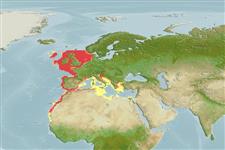Пластиножаберные (акулы и скаты) (sharks and rays) >
Rajiformes (Skates and rays) >
Rajidae (Skates)
Etymology: Leucoraja: Greek, leykos = white + Latin, raja = a fish, Raja sp. (Ref. 45335).
More on authors: Müller & Henle.
Environment: milieu / climate zone / depth range / distribution range
экология
морской демерсальный; пределы глубины 12 - 900 m (Ref. 106604), usually 20 - 250 m (Ref. 11284). Subtropical; 63°N - 15°N, 18°W - 36°E
Eastern Atlantic: Kattegat (Ref. 3167) and North Sea, around Great Britain, Ireland and the Mediterranean to Morocco and Senegal.
Length at first maturity / Size / Вес / Возраст
Maturity: Lm 57.5, range 45 - 71.8 cm
Max length : 81.0 cm TL самец/пол неопределен; (Ref. 106604); 68.0 cm TL (female); common length : 40.0 cm TL самец/пол неопределен; (Ref. 3261)
колючие лучи спинного плавника (общее число) : 0; колючие лучи анального плавника: 0. Snout short; upper surface entirely spinulose, but centre of pectoral fins more or less bare in adults, underside smooth except for prickly front edges; generally 9-13 thorns in a complete row around inner margin of eye, and a large triangle of thorns on nape or shoulder region; two parallel rows of strong thorns on each side of midline along tail; upper surface ochre to light greyish-brown with a large roundish black eye-spot in middle of each pectoral fin, underside white (Ref. 3167)
Feed on all kinds of bottom animals (Ref. 3167). Oviparous. Distinct pairing with embrace. Young may tend to follow large objects, such as their mother (Ref. 205). Eggs are oblong capsules with stiff pointed horns at the corners deposited in sandy or muddy flats (Ref. 205). Egg capsules are 5.0-7.0 cm long and 3.1-3.9 cm wide (Ref. 41250). Around 70-150 eggs are laid per individual annually (Ref. 41250).
Oviparous, paired eggs are laid. Embryos feed solely on yolk (Ref. 50449). Distinct pairing with embrace. Young may tend to follow large objects, such as their mother (Ref. 205).
McEachran, J.D. and K.A. Dunn, 1998. Phylogenetic analysis of skates, a morphologically conservative clade of elasmobranchs (Chondrichthyes: Rajidae). Copeia 1998(2):271-290. (Ref. 27314)
Статус Красного Списка МСОП (Ref. 130435)
Угроза для людей
Harmless
Использование человеком
рыболовство: коммерческий; аквариум: общественные аквариумы
дополнительная информация
инструменты
Специальные отчеты
Скачать в формате XML
ресурсы в Интернет
Estimates based on models
Preferred temperature (Ref.
123201): 7.2 - 16.7, mean 10.5 °C (based on 1278 cells).
Phylogenetic diversity index (Ref.
82804): PD
50 = 0.5000 [Uniqueness, from 0.5 = low to 2.0 = high].
Bayesian length-weight: a=0.00245 (0.00211 - 0.00285), b=3.22 (3.18 - 3.26), in cm total length, based on LWR estimates for this species (Ref.
93245).
Trophic level (Ref.
69278): 4.2 ±0.3 se; based on diet studies.
устойчивость к внешним воздействиям (Ref.
120179): низкий, минимальное время удвоения популяции 4.5-14 лет (K=0.11-0.16; tm=8-9; tmax=28; Fec<100).
Prior r = 0.41, 95% CL = 0.27 - 0.61, Based on 1 full stock assessment.
Fishing Vulnerability (Ref.
59153): Moderate to high vulnerability (48 of 100).
Climate Vulnerability (Ref.
125649): Low to moderate vulnerability (35 of 100).
Nutrients (Ref.
124155): Calcium = 14 [2, 254] mg/100g; Iron = 0.805 [0.076, 9.895] mg/100g; Protein = 16.4 [14.4, 18.5] %; Omega3 = 0.488 [0.206, 1.165] g/100g; Selenium = 28.6 [5.5, 148.2] μg/100g; VitaminA = 8.99 [0.73, 103.53] μg/100g; Zinc = 0.415 [0.024, 4.858] mg/100g (wet weight);
